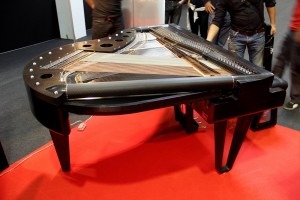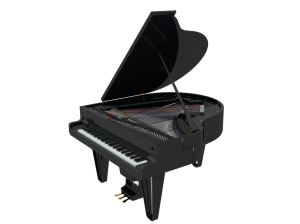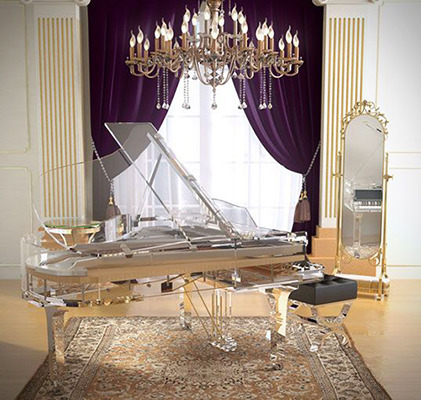 An airliner of the 21st century has relatively little in common with the pioneering efforts of the Wright brothers on a North Carolina beach. Although the basic principles of flight have not changed over the last century, the practical applications and implementations certainly have! And while we all accept—if not actually demand—to reap the benefits of technological advancements in our daily practical lives, the mysterious and tradition-laden universe of piano building has been strangely resistant to the idea of incorporating new technologies and materials. Until now, and the introduction of the “Phoenix Carbiano,” that is! This first commercially available carbon fibre piano, designed by computer science and acoustic engineers, uses advanced composite materials. The principle aim of this radical re-design is to “improve the power, and lengthen the sustain of the notes while enhancing the artist to instrument interface. In addition, the application of new technologies and materials produce an instrument of longer quality life that is significantly more tolerant of adverse climate conditions.”
An airliner of the 21st century has relatively little in common with the pioneering efforts of the Wright brothers on a North Carolina beach. Although the basic principles of flight have not changed over the last century, the practical applications and implementations certainly have! And while we all accept—if not actually demand—to reap the benefits of technological advancements in our daily practical lives, the mysterious and tradition-laden universe of piano building has been strangely resistant to the idea of incorporating new technologies and materials. Until now, and the introduction of the “Phoenix Carbiano,” that is! This first commercially available carbon fibre piano, designed by computer science and acoustic engineers, uses advanced composite materials. The principle aim of this radical re-design is to “improve the power, and lengthen the sustain of the notes while enhancing the artist to instrument interface. In addition, the application of new technologies and materials produce an instrument of longer quality life that is significantly more tolerant of adverse climate conditions.”
 In terms of practical application, what does this actually mean? For one, composite materials have almost completely replaced wood. In the Carbiano model, the casework, frame, soundboard and fittings are manufactured to computer-designed specifications by a British composite firm that also builds cars for Formula 1 companies. By adopting these cutting-edge technologies and materials, the soundboard is now directly suspended from a carbon fibre frame. Advanced bridge technology more efficiently transmits vibration energy from the strings to the soundboard, and the use of carbon fibre tubular shanks in the action provides better feedback and control for the artist. Clearly, this is a significant advance on traditional technology as it allows the instrument to resist atmospheric variables, reducing wear and tear and allowing the piano to stay in tune for longer periods of time. As an immediate result of these technological and material innovations, Phoenix pianos produce about twice as much sound energy as traditional pianos. This simply means that the instrument produces a much bigger and fuller sound, and that notes benefit from a substantially longer sustain. Apparently, the carbon fibre only very marginally changes sound quality, and careful voicing of the hammers easily delivers the required adjustments.
In terms of practical application, what does this actually mean? For one, composite materials have almost completely replaced wood. In the Carbiano model, the casework, frame, soundboard and fittings are manufactured to computer-designed specifications by a British composite firm that also builds cars for Formula 1 companies. By adopting these cutting-edge technologies and materials, the soundboard is now directly suspended from a carbon fibre frame. Advanced bridge technology more efficiently transmits vibration energy from the strings to the soundboard, and the use of carbon fibre tubular shanks in the action provides better feedback and control for the artist. Clearly, this is a significant advance on traditional technology as it allows the instrument to resist atmospheric variables, reducing wear and tear and allowing the piano to stay in tune for longer periods of time. As an immediate result of these technological and material innovations, Phoenix pianos produce about twice as much sound energy as traditional pianos. This simply means that the instrument produces a much bigger and fuller sound, and that notes benefit from a substantially longer sustain. Apparently, the carbon fibre only very marginally changes sound quality, and careful voicing of the hammers easily delivers the required adjustments.
There is no doubt that the “Phoenix Carbiano” is the world’s most advanced piano! The combination of modern technologies and advanced materials has eliminated much of the traditional guesswork associated with piano building. And much praise has to go to the company for achieving this delicate balance between arts and the sciences, while simultaneously greatly improving the instrument’s reliability. To fully realize the potential of this revolutionary instrument, however, will require the composition of a dedicated contemporary piano repertoire. The instrument may also, in due time and with more exposure to various concert stages and artistic interpretations, yield significant musical insights into the glorious legacy of an extended piano repertory tradition.
Phoenix Carbiano






